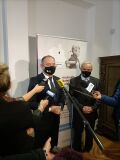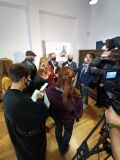back...Graves of children – victims of the German camp – have been found
Historians from the Museum of Polish Children - Victims of Totalitarianism have discovered the burial places of child victims of the German concentration camp in Łódź that had previously remained unknown. The tormented Polish children were buried at the St. Wojciech Roman Catholic Church in Łódź. So far, the researchers have managed to locate 77 such locations. Two graves have remained intact, while the burial places of the other 75 victims are now the graves of other people. The decision on further steps will be made by the Institute of National Remembrance.
The Head of the Museum, Ireneusz Maj (PhD), has notified the Institute of National Remembrance, the Ministry of Culture and National Heritage, and the Prime Minister’s Plenipotentiary for the Protection of Places of Remembrance of this shocking discovery.
The documents examined by the historians of the Museum describe the burial places of 77 victims of German atrocities at the camp for Polish children in Łódź. They all point to the area of the present-day St. Wojciech Roman Catholic Cemetery in Łódź. The documents include the first and last names of the victims buried, the dates of their birth and death, the date and hour of funeral and the precise location of the former graves.
Having analysed the files and conducted documentation work at the cemetery, the museum’s historians found that only two graves have remained intact until the present day: the grave of the 9-year-old Jerzy (which was previously considered the only known grave) and the grave of 12-year-old Zygmunt, discovered on the 3rd of November 2021. As for the remaining 75 victims whose burial places were possible to locate, these places are now occupied by other people’s graves.
“Germans often ordered the Polish children they murdered in the camp to be buried without notifying their families. Consequently, their graves were forgotten and new ones appeared in their place with the passage of time. These children were mistreated both during their lives and after their deaths,” underlines Ireneusz Maj (PhD), Head of the Museum.
He points to the post-war authorities of the Polish People’s Republic as the people primarily responsible for the negligence and for not securing the burial places of the camp’s victims.
“The communist authorities of that time should have secured the graves and commemorated these places. Unfortunately, this has not been done – even after the fall of communism. No one has handled this matter until now. No one has been looking for these graves. For many years, the issue of the burial places of Polish children remained silenced, letting the memory of these innocent victims fade away. But it will not. We will restore the memory of these children and commemorate them in a dignified manner. This is a task of mine and the objective of the Museum of Polish Children. We must not forget,” underlines Ireneusz Maj.
The burial places discovered will now be handled by the prosecutors of the Institute of National Remembrance - Commission for the Prosecution of Crimes against the Polish Nation. They will be responsible for further decisions made regarding this matter.
The Head of the Museum has already applied to the Voivodeship Office in Łodź for entering the discovered intact burial place of the 12-year-old Zygmunt to the register of war graves.
Researchers from the Museum of Polish Children continue their search for other graves – they estimate that it will be possible to locate 200 to 300 such places. However, it is not certain whether all of them are located within the area of the present-day St. Wojciech Roman Catholic Cemetery.






